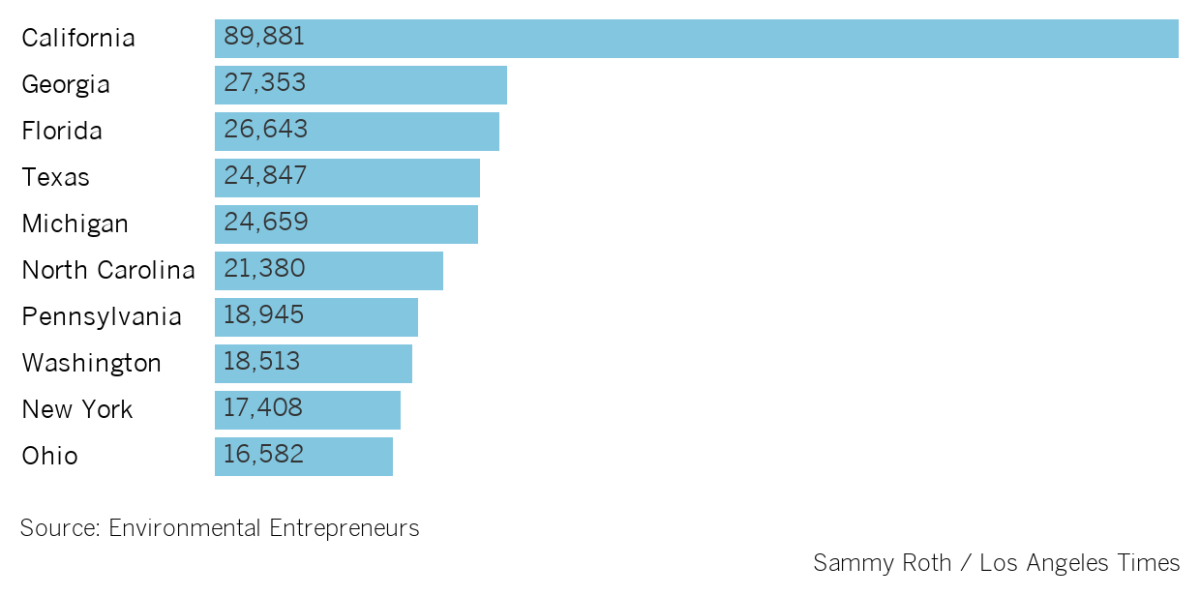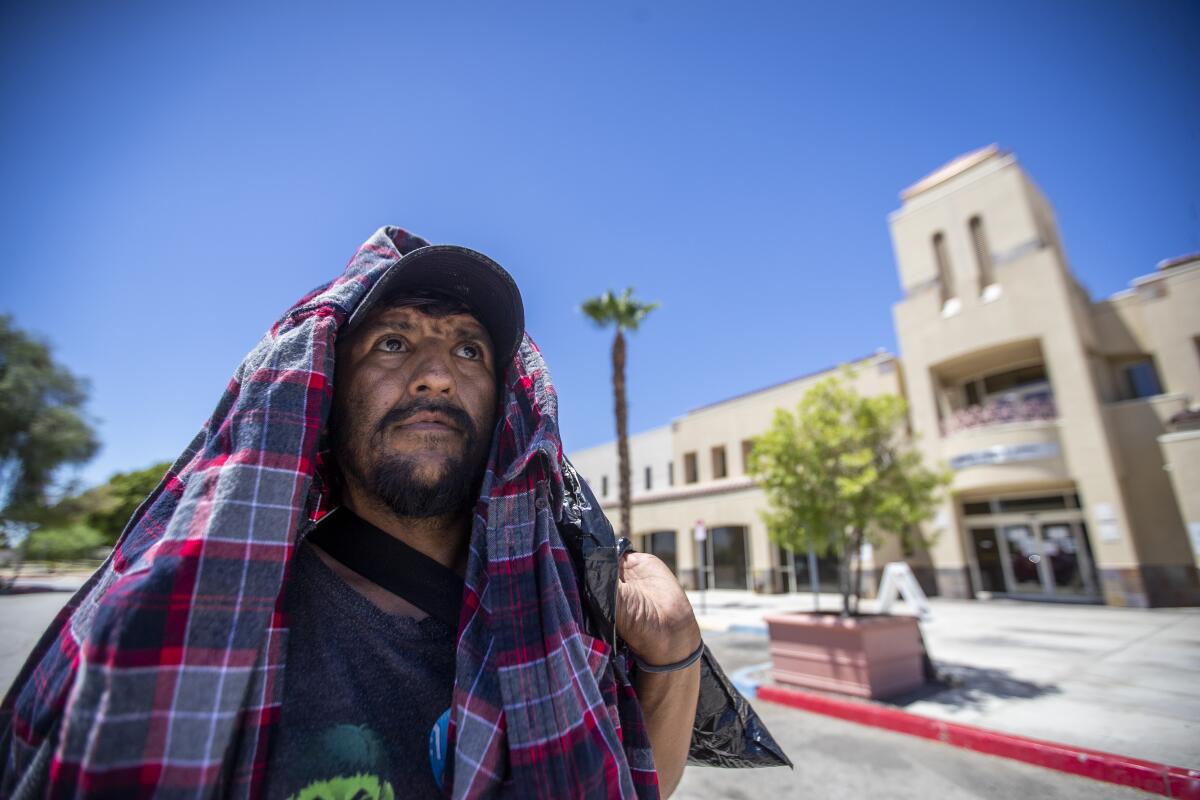California still doesn’t have a plan to bring back clean energy jobs lost to COVID-19
- Share via
Ever since it became clear the COVID-19 pandemic would send the U.S. economy into a tailspin, there’s been lots of talk about using government stimulus funds to create clean energy jobs rather than propping up fossil fuel companies whose business model is fueling the climate crisis.
There’s been a lot more talk than action.
The Energy Policy Tracker says the United States has committed $68 billion to supporting fossil fuels this year, the vast majority going to bail out airlines, which are a major source of planet-warming emissions. The U.S. has committed just $27 billion to support clean energy, mostly through grants to public transit agencies.
Additionally, the Guardian’s Emily Holden reported this month that fossil fuel companies had received at least $3 billion from the federal government, and possibly much more, in the form of forgivable loans meant to support small businesses.
Toward a more sustainable California
Get Boiling Point, our newsletter exploring climate change, energy and the environment, and become part of the conversation — and the solution.
You may occasionally receive promotional content from the Los Angeles Times.
Hardly anybody thought the Trump administration would go big on clean energy stimulus funds, like the Obama administration did during the last economic downtown. Most of the think tanks and advocacy groups pitching ideas for federal action are looking ahead to next year, when Joe Biden might be president.
But in California, there were early signs a clean energy stimulus program could be in the works. Three months ago, I interviewed the climate activist and former Democratic presidential candidate Tom Steyer, who had just been appointed by Gov. Gavin Newsom to co-chair a task force on business and jobs recovery. Steyer told me the group of prominent business leaders would be “looking to produce a more just, green and forward-looking California.”
“The United States as a whole is going to do a huge rebuilding, and we have to do it with an eye to the future,” he said.
Since then, Newsom’s task force has urged Congress to provide $1 trillion in relief for state and local governments, released a letter decrying anti-Black racism and launched a campaign encouraging Californians to shop at small businesses.
But so far, mum’s the word on steps to grow the green workforce.

Some clean energy advocates are getting tired of waiting.
Last week, a coalition of renewable-power companies, industry groups and environmental nonprofits calling itself the Alliance for a Clean Economy sent a letter to Newsom and legislative leaders, urging them to take action. They cited data showing California has lost nearly 90,000 clean energy jobs since the coronavirus outbreak began.
“The state must take action, and soon, to stem further losses,” the coalition wrote. “Harnessing clean energy’s potential as an engine for economic recovery will require marshaling the coordinated capabilities of California’s agencies, and focusing them on actions to spur increased employment and investment now.”
The job losses are staggering, as I explained in more detail in May. Despite a slight rebound in June, the U.S has shed more than half a million clean energy jobs in four months, out of an overall workforce of nearly 3.4 million before COVID-19, according to the advocacy group Environmental Entrepreneurs.
I made a chart showing which states have lost the most jobs:

The Alliance for a Clean Economy also sent Newsom a four-page list of recommendations, focused on what the state can do to support clean energy jobs without approving major new expenditures or legislation. The ideas include:
- Speed up the release of already authorized funds, including incentives for homes to install rooftop solar panels and batteries through the Self-Generation Incentive Program and the Solar on Multifamily Affordable Housing program;
- Encourage local governments to adopt rules for virtual inspection and permitting of rooftop solar systems, electric vehicle charging stations and clean energy microgrids;
- Expand incentive programs, funded by utility ratepayers, that encourage construction of all-electric homes and installation of low-emission space and water heaters;
- Require utility companies to ramp up renewable energy purchases more quickly than currently required under state law;
- Adopt a far more aggressive target for reducing carbon emissions from power plants over the next decade.
That last one caught my attention because I wrote a story in March questioning whether the 2030 emissions target adopted by the state’s Public Utilities Commission is too weak.
Since then, California’s longer-term goal of 100% climate-friendly electricity by 2045 — considered hugely ambitious when lawmakers approved it two years ago — has started to look less impressive than it once did. Under pressure from climate activists, Biden last week announced a goal of 100% clean electricity nationwide by 2035.
V. John White, a veteran clean energy lobbyist who helped organize the letter to Newsom, told me the coalition is still waiting to hear back from the governor’s office.
“We basically tried to give them a guidepost for what needs to be done,” he said. “The sad story is we’re losing jobs and we’re losing momentum, and a good deal of what’s wrong is stuff we ought to be able to fix.”
White pointed to publicly owned utilities in Sacramento and Los Angeles as models for the rest of the state. Sacramento Municipal Utility District, known as SMUD, last week declared a “climate emergency” and said it would aim for 100% carbon-neutral electricity by 2030, as Utility Dive’s Kavya Balaraman reported. And the Los Angeles Department of Water and Power is working with the National Renewable Energy Laboratory to finalize a detailed study outlining possible paths to 100% renewable energy.
“Between LADWP and SMUD, the silence from Newsom is kind of deafening,” White told me.

I asked Newsom’s office for a response to the coalition’s letter, and for any information it could provide on the progress of the governor’s task force. The administration didn’t provide a response by press time. But in interviews after this newsletter was published, Steyer and Jared Blumenfeld, secretary of the California Environmental Protection Agency, described to me a detailed list of ideas they said the task force is workshopping.
Blumenfeld said the group has discussed a new financing mechanism to promote electric vehicles, strategies to promote working from home even after the pandemic has ended and possibly a “climate justice corps” jobs program to put Californians back to work on conservation projects. He said the many corporate executives on the task force are eager for the private sector to contribute and agree that “we can’t go back to business as usual.”
Steyer acknowledged the letter from the Alliance for a Clean Economy, saying he met this week with representatives from two groups that are part of it, the American Wind Energy Assn. and the Solar Energy Industries Assn. “We’ll give advice to the governor on all those things. We’re on it,” he said.
If Biden is elected president, he would have plenty of ideas to run with come January. This week, for instance, Columbia University’s Center on Global Energy Policy and the think tank Resources for the Future released a report finding the U.S. could create as many as 120,000 jobs plugging up to half a million oil and gas wells for an investment between $12 billion and $24 billion.
Such a program could have an especially meaningful jobs impact because fossil fuel companies are going bankrupt left and right, as low prices batter an industry that was already loaded with debt. California Resources Corp., the state’s largest oil and gas producer, is only the latest casualty, as Janet Wilson and Mark Olalde report for the Desert Sun. A national program to plug abandoned wells would put oil and gas workers back to work while also reducing heat-trapping methane emissions.
Whatever happens next, evidence was piling up before the pandemic that a healthy economy and high levels of clean energy can coexist. Last week, the California Energy Commission reported that 63% of the state’s retail electricity supply in 2019 came from carbon-free sources, including solar, wind, geothermal, hydropower and nuclear.
And don’t forget: The climate clock is ticking. As I noted least week, 2020 may be the hottest year ever recorded. One way or another, we’re going to have to deal with that.
And now, here’s what’s happening around the West:
TOP STORIES
The Sierra Club is reckoning with the racism of its famed co-founder. The environmentalist John Muir campaigned to protect Yosemite Valley and helped form the national park system. But Muir also made racist statements about Black and indigenous people. The Sierra Club is now grappling publicly with that legacy — and with the continued disconnect between white-dominated environmental organizations and communities of color, as my colleagues Susanne Rust, Bettina Boxall and Rosanna Xia report.
An appeals court ruled that millions of acre-feet of Colorado River water belong to the Imperial Valley as a whole, not just to landowning farmers. I wrote in this newsletter last month about the high-stakes lawsuit brought by Mike Abatti against the Imperial Irrigation District, seeking greater control for farmers of the largest Colorado River water right in the West. A three-judge panel has ruled largely in the irrigation district’s favor, as the Desert Sun’s Mark Olalde reports.
Pacific Gas & Electric caused the Kincade fire. Investigators have chalked up yet another massive blaze to PG&E’s infrastructure, this one an October 2019 conflagration that burned 77,000 acres in Sonoma County but fortunately didn’t kill anyone, as Joseph Serna reports for The Times. With peak fire season approaching once again, California’s new wildfire safety division is hurrying to inspect PG&E’s poles and wires, as the San Francisco Chronicle’s J.D. Morris reports.
CLIMATE IMPACTS

In California’s Inland Empire, brutal heat and COVID-19 are a frightening combination. In last week’s newsletter, I noted that extreme heat can be extremely deadly, and that climate change is making heat waves worse. This week, The Times’ Stephanie Lai ventured into the desert to write about one of the most vulnerable populations: the homeless. The pandemic is only increasing the likelihood of deaths, by limiting the amount of space available at cooling centers.
A new study is projecting bigger, badder atmospheric rivers in California as climate change worsens. The findings from UCLA researchers “mean that a worst-case storm scenario, on par with the Great Flood of 1862 that turned the Central Valley into a raging sea and took countless lives, is a real possibility,” as Kurtis Alexander reports for the San Francisco Chronicle.
The Senate approved the Great American Outdoors Act, cementing billions of dollars in funding for habitat protection and maintenance in national parks. But even as conservationists celebrated, Carl Segerstrom wrote a thoughtful piece for High Country News pointing out that the bill continues to fund conservation programs with taxes and royalties from oil and gas drilling — in effect making it harder to wean the United States off fossil fuels, at least without slashing conservation programs.
Enjoying this newsletter? Consider subscribing to The Times
Your support helps us deliver the news that matters most, and makes newsletters like Boiling Point possible. Become a Los Angeles Times subscriber.
POWER STRUGGLES
Tesla’s insane stock price makes sense in a market gone mad. That’s the attention-grabbing headline on this excellent story by my colleague Russ Mitchell, who tries to figure out why the stock market now considers Elon Musk’s electric carmaker more valuable than Toyota, Volkswagen and Ford combined. Along the way, Russ highlights some of Musk’s eye-popping but as-yet-unfulfilled promises, including the production of electric semi-trucks and a thriving business selling solar roofs.
What do oil companies really mean when the promise net-zero emissions by 2050? Writing for InsideClimate News, Nicholas Kusnetz digs into this increasingly popular pledge among Big Oil executives, and finds the whole concept is much more public relations than a serious climate strategy. “Most glaring is that none of the companies has committed to cut its oil and gas output over the next decade, the simplest and most reliable way — one might say the only way — to cut emissions,” Kusnetz writes.
Kemp’s ridley is the world most endangered sea turtle species, and its hatchlings are adorable. (See the above photo if you don’t believe me.) For the last 40 years, the National Park Service has worked diligently to protect Kemp’s ridley nests at Padre Island National Seashore in Texas, culminating in an annual event where thousands of people watch the hatchlings released into the surf. But now the Trump administration wants to slash funding for the program, as Anna M. Phillips reports for The Times.
WATER AND POWER
Coal plants use loads of water in the water-starved West. And now we have a better idea how much: A new report finds that 30 coal-fired generating units across the region collectively use around 76 billion gallons annually, according to the Colorado Sun’s Mark Jaffe. The big question is what will happen to those surface water and groundwater rights as more coal plants close (which seems pretty likely due to economics and state climate policies, as I wrote earlier this year).
Federal officials have thrown a wrench into the largest dam removal in U.S. history. A coalition of tribes, environmentalists and salmon-fishing interests has been trying for years to tear down four dams on the Klamath River, along the California-Oregon border. But the plan could be jeopardized by a decision last week from the Federal Energy Regulatory Commission, per the AP’s Gillian Flaccus. The snag involves PacifiCorp, one of several utilities owned by Warren Buffett’s Berkshire Hathaway Energy.
If you’re hanging out by the ocean these days, be careful what you fish for. The Times’ Louis Sahagun reports that since the pandemic started, people have been swarming a coastal tide pool on the Palos Verdes Peninsula and harvesting creatures such as mussels, black turban snails and purple sea urchins for food and recreation — often without a sportfishing license. It may seem harmless, but the shellfish grab, fueled by social media, is putting a delicate ecosystem at risk.
What do you want to know?
When you think about California’s climate future, what comes to mind? What keeps you up at night, and what gives you hope or gets you excited? What do you want to understand, and what should I?
This newsletter is for you, to help you understand how we’re changing our world and what we can do about it, and I want to hear your questions, concerns and ideas. Email me or find me on Twitter.
ONE MORE THING
I was disappointed earlier this year when I did not win a permit to hike Mt. Whitney, the highest peak in the Lower 48, through the federal government’s annual lottery. So for now I’m living vicariously through my colleague Rachel Schnalzer, who summited Whitney this month and wrote about her experience on the trail during a time of mask-wearing and social distancing.
Short version: It’s hard to keep your mask on the whole time, but there’s plenty of space to stay six feet apart.
And my gosh, does it look gorgeous up there:
I’ll be back in your inbox next week. If you enjoyed this newsletter, please consider forwarding it to your friends and colleagues.






